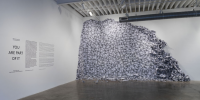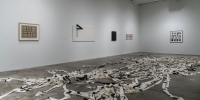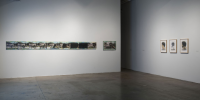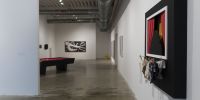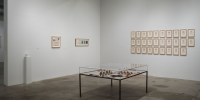Works from the Ella Fontanals-Cisneros Collection
Curated by: Eugenio Valdés Figueroa & Katrin Steffen
CIFO Art Space, Miami │ November 30, 2016 - March 12, 2017
“The overriding desire of most little brats, on the other hand, is to get at and see the soul of their toys, either at the end of a certain period of use, or on occasion straightaway. On the more or less swift invasion of this desire depends the lifetime of the toy. I cannot find it in me to blame this infantile mania: it is the first metaphysical stirring. When this desire has planted itself in the child’s cerebral marrow, it fills his fingers and nails with an extraordinary agility and strength. He twists and turns the toy, scratches it, shakes it, bangs it against the wall, hurls it on the ground. From time to time he forces it to continue its mechanical motions, sometimes in the opposite direction. Its marvelous life comes to a stop. The child, like the populace besieging the Tuileries, makes a last supreme effort; finally he pries it open, for he is the stronger party. But where is its soul? This moment marks the beginnings of stupor and melancholy.
There are other children who must instantly break any toy that is placed in their hands, almost without inspecting it; as to these, I confess I do not understand the mysterious motive which causes their action. Are they seized by a superstitious furor against these tiny objects which imitate humanity, or are they perhaps forcing them to undergo some Masonic initiation before introducing them into nursery life? -‘Puzzling question’1
1 Gross, Kenneth, ed. On Dolls. London: Notting Hill Editions, 2012. Print. “The Philosophy of Toys,” Charles Baudelaire pgs.11-21
Charles Baudelaire, France, 1853
In 1965, on the occasion of the exhibition “The Responsive Eye” at the Museum of Modern Art, NY, its curator, William C. Seitz, pointed out that the works featured “exist less as objects to be examined than as generators of perceptual responses in the eye and mind of the viewer.” After the Second World War, a trend emerged—both in the art of the times as well as in its market—to stress “perceptual” relationships, while new conceptual relationships were gradually being forged, which Seitz himself was unable to ignore despite the predominant formalist approach that the commercial circuit proceeded to impose from the gallery upon public and private collectors. The same year that “perceptual art” was coined at MoMA and touted in the New York circuit and that Denise René promoted kinetic art in her galleries, one of the first works of conceptual art, One and three chairs by Josef Koluth, was exhibited at the Musée de la Ville de Paris.
A tense, almost promiscuous yet productive situation began to evolve from the connecting points between perceptual responses and those of “the mind,” alienating the aesthetic experience more and more from the binding ties of the artistic object. Thereafter, “art idea” had a growing impact on the rewriting of the rules of the game of art and its institutional circuits. Several offshoots of those experiences led to minimalism, actionism and performance art, to “environments” (as they were then called), installations and interventions in public spaces. Conceptual art went from being a trend to a way of thinking and acting. It is curious to note that the most daring experiences of so-called kinetic art were conceptual, actionist and political in nature.
In art, it is not the same thing to speak of “toy” and of “game.” In one case, we are referring to the object; in the other, to the action and to the spatial relationships between the work and the public. Within the history of art, it is possible to pinpoint those artists who propose to reinvent the rules of the game (which definitely means reinventing art, guaranteeing its return to processes and non-conclusions). There are also those artists who are good players, who stretch the limits, who always make the game more interesting and may even make it better. They are comparable to high-performance athletes. In our opinion, an inventor of games has the same merit as the players who turn a match into a unique event that justly earns its place in history. This exhibition, featuring works from the Ella Fontanals-Cisneros collection, is made up of exceptional toys, actions, game inventors and players, where some of their main thematic axes intertwine and take on other meanings.
Pioneer art critic Charles Baudelaire was incisive in his writings on the Salons of 19th century Paris. The Frenchman detected a game change and he himself became one of its new founding principles. One of the most important texts on aesthetics and art is a story that he uses as a metaphor —the relationship of children to their toys— to speak on morality in those new founding principles of art and of society. He heralded a path that would evolve into modern art during the first half of the 20th century and crystallize into contemporary art practices and attitudes during the post-WWII and Cold War eras.
The exhibition Toda percepción es una interpretación: You are part of it is a retrospective look from the viewpoint of contemporary issues of art, culture, politics and economics. It seeks to reflect on the successive re-configurations of the art map in the last few decades, on the displacements and relocations of its primary centers, from Paris to New York, from Venice to São Paulo, from Basel to Miami. It speaks of areas that have succeeded in alternating centripetal or centrifugal forces, where art has relocated its meeting points and its observation points. We also pay attention to the effects of redrawing the financial or political map, with the repercussion it has on how one makes and proceeds in art.
Liliana Porter’s statement, from which we take the title of our research on the collection, sums up the main hypothesis, while simultaneously acting as a hint to the visitor. It alerts him that he will insert himself in certain mental maps, in certain “puzzling questions,” as Baudelaire would say. The concerns are similar, and the counterpoints revelatory, regardless of the fact that they hail from different latitudes or generations. Here, what is more important is the place in the lines of thought where these artists are. From the outset, You are part of it is an invitation to participate actively, not just with the eyes, nor even with the body. Untangling enigmas demands a game of another sort — the “responsive mind.” The great problem of our times, in the era of complex systems, lies in our having to choose between freedom and security. The balance between the two is extremely fragile. If something breaks, we would always wonder the same thing: But where is its soul?
Artists in the exhibition:
Elena Asins (Spain) | Kader Attia (France) | Robert Barry (U.S) | Pavel Büchler (U.K) | Paulo Bruscky (Brazil) | Waltercio Caldas (Brazil) | Luis Camnitzer (Uruguay) | Arturo Cuenca (Cuba) | Sandu Darie Romania (Cuba) | Antonio Dias (Brazil) | Iran do Espírito Santo (Brazil) | Juan Downey (Chile, U.S) | Marcel Duchamp (France) | Juan Francisco Elso (Cuba) | Eugenio Espinoza (Venezuela) | León Ferrari (Argentina) | Marcius Galan (Brazil) | Flavio Garciandía (Cuba) | José Antonio Hernández-Diez (Venezuela) | Karlo Andrei Ibarra (Puerto Rico) | Joseph Kosuth (U.S) | Barbara Kruger (U.S) | David Lamelas (Argentina) | Judith Lauand (Brazil) | Glenda León (Cuba) | Carlos Leppe (Chile) | Anna Maria Maiolino (Brazil) | Antonio Manuel (Brazil) | Carlos Martiel (Cuba) | Cildo Meireles (Brazil) | Marta Minujín (Argentina) | Priscilla Monge (Costa Rica) | Hélio Oiticica (Brazil) | Lygia Pape (Brazil) | Michelangelo Pistoletto (Italy) | Liliana Porter (Argentina) | Carlos Rodríguez Cárdenas (Cuba) | Lázaro Saavedra (Cuba) | Mira Schendel (Brazil) | Franz Erhard Walther (Germany) | Horacio Zabala (Argentina)
Installation view of Toda Percepcion es una interpretación: You Are Part of It at CIFO Art Space, Miami. Photos: Oriol Tarridas. © CIFO | Cisneros Fontanals Art Foundation

